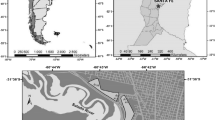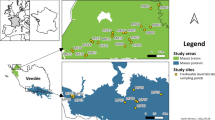Abstract
Artificially created ponds in urban areas may be important biodiversity refugia and may provide recreational services for populations. In order to obtain information on the seasonal development of the environmental conditions, water quality was determined in ten clay-pit ponds situated in the Austrian capital, Vienna. These ponds show high electrical conductivity (up to 3,000 μS cm − 1), indicating elevated levels of salinity, which can be attributed to the geological setting of the underground. Furthermore, the ponds experience a gradient from low to high human pressure resulting from recreational activities (swimming, fishing, urbanisation of the pond boundaries). Results obtained from multivariate statistics methods suggest that ponds were mainly structured by salinity and by algal biomass, which can be attributed to resource supply related with eutrophication. According to their water chemistry, the ponds were classified as meso- to hypereutrophic. Stoichiometric N/P ratios suggest that phytoplankton productivity in hypereutrophic ponds is nitrogen limited, whilst algae in ponds with lower trophic levels experience growth imitation by phosphorus depletion. We eventually related environmental conditions to algal species occurrences and developed a model for algal assemblages indicating the particular trophic state at different seasons.
Similar content being viewed by others
References
Angeler, D. G., Viedma, O., Sánchez-Carrillo, S., & Alvarez-Cobelas, M. (2008). Conservation issues of temporary wetland Branchiopoda (Anostraca, Notostraca: Crustacea) in an agricultural landscape: what spatial scales are relevant? Biological Conservation, 141, 1224–1234. doi:10.1016/j.biocon.2008.02.018.
Beukler, C., Lessmann, D., & Nixdorf, B. (2003). Aspects of phytoplankton succession and spatial distribution in an acidic mining lake (Plessa 117, Germany). Acta Oecologica, 24, 25–31. doi:10.1016/S1146-609X(02)00005-X.
De Meester, L., Declerck, S., & Stoks, R. (2005). Ponds and pools as model systems in conservation biology, ecology and evolutionary biology. Aquatic Conservation, 15, 715–725. doi:10.1002/aqc.748.
De Nicola, D. M., de Eyto, E., Wemaere, A., & Irvine, K. (2003). Production and respiration of epilithic algal communities in Irish lakes of different trophic status. Archiv für Hydrobiologie, 157, 67–87.
EPCN (European Pond Conservation Network). (2007). Developing the pond manifesto. Annals of Limnology—International. Journal of Limnology, 43, 221–232.
Forsberg, C. G., & Ryding, S. O. (1980). Eutrophication parameters and trophic state indices in 30 Swedish waste-receiving lakes. Archiv fuer Hydrobiologie, 89, 189–207.
Gätz, N. (1993). Die Autökologie von Peridiniopsis borgei Lemm. (Dinophyceae) im Windradlteich bei Guntramsdorf, Niederösterreich. Dissertation, Universität Wien.
Gätz, N., & Schagerl, M. (1990). Peridiniopsis borgei Lemm. - eine seltene Dinophyceae in Ziegelteichen in Wien und Niederösterreich. Lauterbornia, 4, 24–29.
Irvine, K., Allot, N., de Eyto, E., Free, G., White, J., Caroni R., et al. (2001). Ecological assessment of Irish lakes, final report. Environmental Protection Agency. Ireland: Wexford.
Kalff, J., & Knoechel, R. (1978). Phytoplankton and their dynamics in oligotrophic and eutrophic lakes. Annual Review of Ecology and Systematics, 9, 475–495. doi:10.1146/annurev.es.09.110178.002355.
Kalin, M., Cao, Y., Smith, M., & Olaveson, M. M. (2001). Development of the phytoplankton community in a pit lake in relation to water quality changes. Water Research, 35, 3215–3225. doi:10.1016/S0043-1354(01)00016-1.
Komárek, J., & Fott, B. (1983). Chlorophyceae (Grünalgen), Ordnung: Chlorococcales. In G. Huber-Pestalozzi (Ed.), Das Phytoplankton des Süßwassers, Heft 7/1. Stuttgart: Schweitzerbart’sche Verlagsbuchhandlung.
Krammer, K., & Lange-Bertalot, H. (1991). Bacillariophyceae, Teil 3: Centrales, Fragilariaceae, Eunotiaceae. In H. Ettl, G. J. Gerloff, H. Heynig, & D. Mollerhauer (Eds.), Süßwasserflora von Mitteleuropa, Band 2/3. Stuttgart: G. Fischer Verlag.
Lampert, W., & Sommer, U. (1999). Limnoökologie (2nd ed.). Stuttgart: Thieme Verlag.
Legler, C. (1988). Ausgewählte Methoden der Wasseruntersuchung. Band 1: Chemische, physikalisch-chemische und physikalische Methoden. Jena: G. Fischer Verlag.
Lorenzen, C. J. (1967). Determination of chlorophyll and phaeopigments: Spectrophotometric equations. Limnology and Oceanography, 12, 343–346.
Mitsch, W. J., & Gosselink, J. G. (2000). Wetlands (3rd ed.). New York: Van Nostrand Reinhold.
Moy, L. D., & Levin, L. A. (1991). Are Spartina marshes a replaceable resource—a functional-approach to evaluation of marsh creation efforts. Estuaries, 14, 1–16. doi:10.2307/1351977.
Müllner, U. (1999). Ziegelteiche im Gebiet südlicher Wiener Stadtrand und Umgebung. Master thesis BOKU, Wien.
Reynolds, C. S. (1988). The concept of ecological succession applied to seasonal periodicity of freshwater phytoplankton. Verhandlungen der Internationalen Vereinigung Limnologie, 23, 683–691.
Reynolds, C. S. (1997). Vegetation processes in the pelagic: A model for ecosystem theory. Oldendorf/Luhe: The Ecology Institute.
Reynolds, C. S., Huszar, V., Kruk, C., Naselli-Flores, L., & Melo, S. (2002). Review towards a functional classification of the freshwater phytoplankton. Journal of Plankton Research, 24, 417–428. doi:10.1093/plankt/24.5.417.
Rott, E. (1997). Indikationslisten für Aufwuchsalgen. Teil 1: Saprobielle Indikation. Wien: Bundesministerium für Land- und Forstwirtschaft, Wasserwirtschaftskataster.
Schagerl, M., Bloch, I., & Vietauer, A. (2007). Naturinseln im Siedlungsgebiet. Ziegelteiche in Wien und Niederösterreich. Eine ökologische Studie zur Erfassung hydrochemischer Eigenschaften und deren Einfluss auf Algengemeinschaften. Abhandlungen der Zoologisch-botanischen Gesellschaft, Österreich, 36, 1–94.
Schwoerbel, J. (1994). Methoden der Hydrobiologie. Jena: G. Fischer Verlag.
Starmühlner, F., & Ehrendorfer, F. (1970). Naturgeschichte Wiens. Band I. Wien: Jugend und Volk.
Author information
Authors and Affiliations
Corresponding author
Rights and permissions
About this article
Cite this article
Schagerl, M., Bloch, I., Angeler, D.G. et al. The use of urban clay-pit ponds for human recreation: assessment of impacts on water quality and phytoplankton assemblages. Environ Monit Assess 165, 283–293 (2010). https://doi.org/10.1007/s10661-009-0945-2
Received:
Accepted:
Published:
Issue Date:
DOI: https://doi.org/10.1007/s10661-009-0945-2




